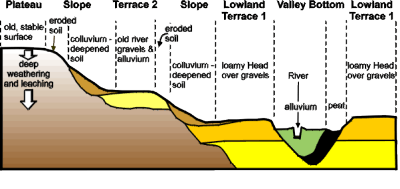 |
| Variations in topography |
We'll get this settled right up front: no, this post has nothing to do with the song by Kenny Rogers. What it does have to do with is, depending on your point of view, physical geography or geomorphology.
James, if that's his real name, starts off with a dull thud:"The land offers diverse topography that is distributed the world over unevenly. These geographical features that grace the Earth’s surface have ways in which they came to be formed. Geographers and geologists, the professionals who study land forms, explain that these geographical features were formed by processes such as vulcanicity (volcanic or igneous activity), faulting and folding processes. Examples of land topography include mountains, plateaus, plains and valleys."Reuben's odd syntax notwithstanding, his list above comprises only half of what causes different landforms: he left out weathering and erosion, which are the agents by which the geologic features are ultimately shaped. Following are some of Reuben's other sometimes rather strange ideas: |
- "Mountains are the most distinct form of land topography mainly due to their altitude. These land masses protrude well off the surface of the earth to a considerable height of more than 1,000 feet above the base point. Hills on the other hand only cover a height of about 500 to 999 feet above the base." – Snicker... if hills "only cover a height of about 500 to 999 feet," what are features shorter than 500 feet? Bumps? Lumps?
- "Sometimes instead of faulting resulting to block mountains, the middle block sinks leaving two blocks of land forms at the sides known as escarpments. These escarpments more often than not are mountains. The block that sank is known as a valley." – Well, technically, the sunken block is a "graben," but only a complete moron thinks all valleys are down-dropped fault blocks.
- But wait, Reuben also says, "The most well-known valley is the Great Rift Valley, which runs for about 6,400 kilometers from Jordan, Syria, to central Mozambique in Africa..." – Really? the "most well-known valley"? And just out of curiosity, Reuben, how did this valley form, huh?
- Oh, now we get it: "There are several types of valleys according to their formation, such as rift valleys, glacial valleys, river valleys and hanging valleys." – Just an FYI, Reuben, a hanging valley is a river valley that "hangs" way up the side of a glacial valley...
- "Plains are land forms that are relatively flat or gently rolling, sometimes extensively for several miles." – Oh, wow: "several miles"!
copyright © 2018-2022 scmrak
SI - GEOGRAPHY
No comments:
Post a Comment